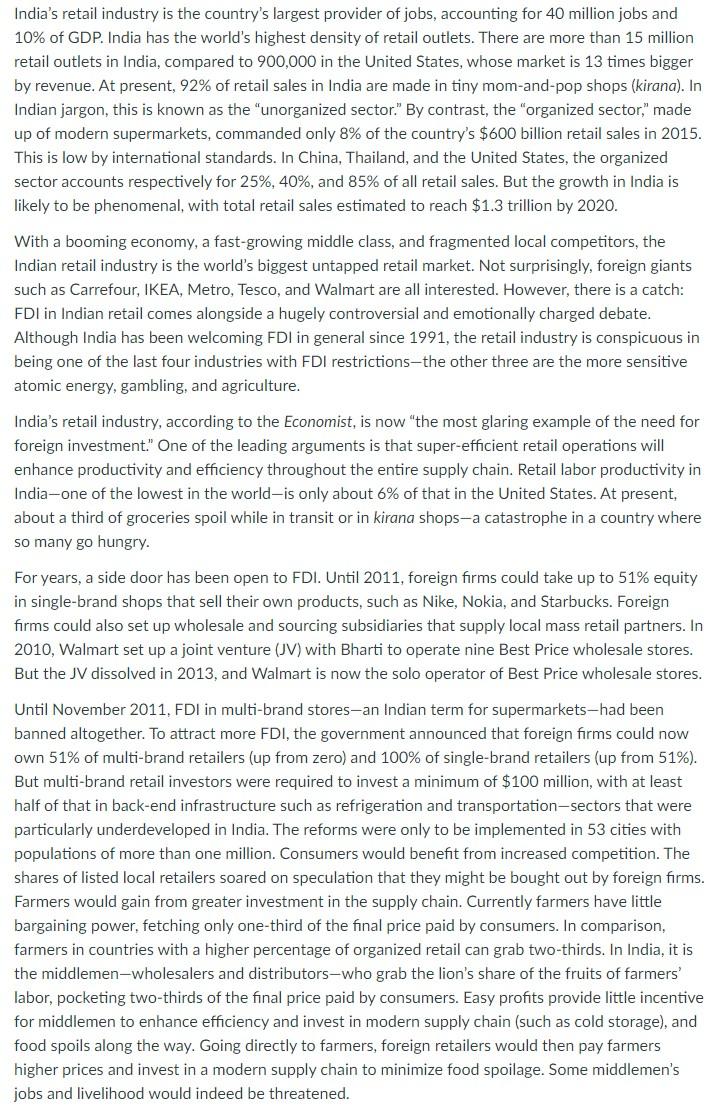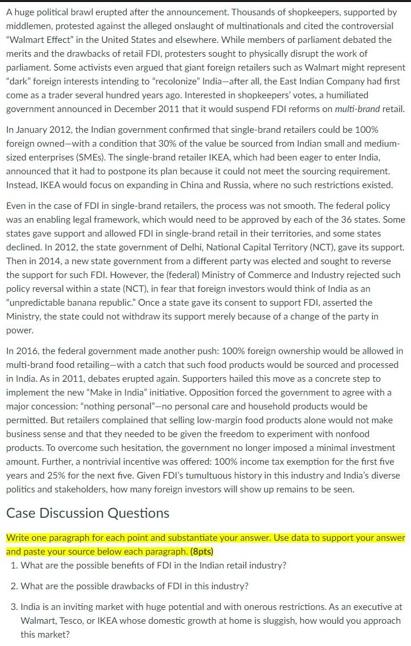Answered step by step
Verified Expert Solution
Question
1 Approved Answer
India's retail industry is the country's largest provider of jobs, accounting for 40 million jobs and 10% of GDP. India has the world's highest


India's retail industry is the country's largest provider of jobs, accounting for 40 million jobs and 10% of GDP. India has the world's highest density of retail outlets. There are more than 15 million retail outlets in India, compared to 900,000 in the United States, whose market is 13 times bigger by revenue. At present, 92% of retail sales in India are made in tiny mom-and-pop shops (kirana). In Indian jargon, this is known as the "unorganized sector." By contrast, the "organized sector," made up of modern supermarkets, commanded only 8% of the country's $600 billion retail sales in 2015. This is low by international standards. In China, Thailand, and the United States, the organized sector accounts respectively for 25%, 40%, and 85% of all retail sales. But the growth in India is likely to be phenomenal, with total retail sales estimated to reach $1.3 trillion by 2020. With a booming economy, a fast-growing middle class, and fragmented local competitors, the Indian retail industry is the world's biggest untapped retail market. Not surprisingly, foreign giants such as Carrefour, IKEA, Metro, Tesco, and Walmart are all interested. However, there is a catch: FDI in Indian retail comes alongside a hugely controversial and emotionally charged debate. Although India has been welcoming FDI in general since 1991, the retail industry is conspicuous in being one of the last four industries with FDI restrictions-the other three are the more sensitive atomic energy, gambling, and agriculture. India's retail industry, according to the Economist, is now "the most glaring example of the need for foreign investment." One of the leading arguments is that super-efficient retail operations will enhance productivity and efficiency throughout the entire supply chain. Retail labor productivity in India-one of the lowest in the world-is only about 6% of that in the United States. At present, about a third of groceries spoil while in transit or in kirana shops-a catastrophe in a country where so many go hungry. For years, a side door has been open to FDI. Until 2011, foreign firms could take up to 51% equity in single-brand shops that sell their own products, such as Nike, Nokia, and Starbucks. Foreign firms could also set up wholesale and sourcing subsidiaries that supply local mass retail partners. In 2010, Walmart set up a joint venture (JV) with Bharti to operate nine Best Price wholesale stores. But the JV dissolved in 2013, and Walmart is now the solo operator of Best Price wholesale stores. Until November 2011, FDI in multi-brand stores-an Indian term for supermarkets-had been banned altogether. To attract more FDI, the government announced that foreign firms could now own 51% of multi-brand retailers (up from zero) and 100% of single-brand retailers (up from 51%). But multi-brand retail investors were required to invest a minimum of $100 million, with at least half of that in back-end infrastructure such as refrigeration and transportation-sectors that were particularly underdeveloped in India. The reforms were only to be implemented in 53 cities with populations of more than one million. Consumers would benefit from increased competition. The shares of listed local retailers soared on speculation that they might be bought out by foreign firms. Farmers would gain from greater investment in the supply chain. Currently farmers have little bargaining power, fetching only one-third of the final price paid by consumers. In comparison, farmers in countries with a higher percentage of organized retail can grab two-thirds. In India, it is the middlemen-wholesalers and distributors-who grab the lion's share of the fruits of farmers' labor, pocketing two-thirds of the final price paid by consumers. Easy profits provide little incentive for middlemen to enhance efficiency and invest in modern supply chain (such as cold storage), and food spoils along the way. Going directly to farmers, foreign retailers would then pay farmers higher prices and invest in a modern supply chain to minimize food spoilage. Some middlemen's jobs and livelihood would indeed be threatened. A huge political brawl erupted after the announcement. Thousands of shopkeepers, supported by middlemen, protested against the alleged onslaught of multinationals and cited the controversial "Walmart Effect" in the United States and elsewhere. Whille members of parliament debated the merits and the drawbacks of retail FDI, protesters sought to physically disrupt the work of parliament. Some activists even argued that giant foreign retailers such as Walmart might represent "dark" foreign interests intending to "recolonize" India-after all, the East Indian Company had first come as a trader several hundred years ago. Interested in shopkeepers' votes, a humiliated government announced in December 2011 that it would suspend FDI reforms on multi-brand retail. In January 2012, the Indian government confirmed that single-brand retailers could be 100% foreign owned-with a condition that 30% of the value be sourced from Indian small and medium- sized enterprises (SMEs). The single-brand retailer IKEA, which had been eager to enter India, announced that it had to postpone its plan because it could not meet the sourcing requirement. Instead, IKEA would focus on expanding in China and Russia, where no such restrictions existed. Even in the case of FDI in single-brand retailers, the process was not smooth. The federal policy was an enabling legal framework, which would need to be approved by each of the 36 states. Some states gave support and allowed FDI in single-brand retail in their territories, and some states declined. In 2012, the state government of Delhi, National Capital Territory (NCT), gave its support. Then in 2014, a new state government from a different party was elected and sought to reverse the support for such FDI. However, the (federal) Ministry of Commerce and Industry rejected such policy reversal within a state (NCT), in fear that foreign investors would think of India as an "unpredictable banana republic." Once a state gave its consent to support FDI, asserted the Ministry, the state could not withdraw its support merely because of a change of the party in power. In 2016, the federal government made another push: 100% foreign ownership would be allowed in multi-brand food retailing-with a catch that such food products would be sourced and processed in India. As in 2011, debates erupted again. Supporters hailed this move as a concrete step to implement the new "Make in India" initiative. Opposition forced the government to agree with a major concession: "nothing personal-no personal care and household products would be permitted. But retailers complained that selling low-margin food products alone would not make business sense and that they needed to be given the freedom to experiment with nonfood products. To overcome such hesitation, the government no longer imposed a minimal investment amount. Further, a nontrivial incentive was offered: 100% income tax exemption for the first five years and 25% for the next five. Given FDI's tumultuous history in this industry and India's diverse politics and stakeholders, how many foreign investors will show up remains to be seen. Case Discussion Questions Write one paragraph for each point and substantiate your answer. Use data to support your answer and paste your source below each paragraph. (8pts) 1. What are the possible benefits of FDI in the Indian retail industry? 2. What are the possible drawbacks of FDI in this industry? 3. India is an inviting market with huge potential and with onerous restrictions. As an executive at Walmart, Tesco, or IKEA whose domestic growth at home is sluggish, how would you approach this market?
Step by Step Solution
There are 3 Steps involved in it
Step: 1
1 The possible benefits of Foreign Direct Investment FDI in the Indian retail industry are significant FDI can lead to increased competition which can benefit consumers through lower prices and a wide...
Get Instant Access to Expert-Tailored Solutions
See step-by-step solutions with expert insights and AI powered tools for academic success
Step: 2

Step: 3

Ace Your Homework with AI
Get the answers you need in no time with our AI-driven, step-by-step assistance
Get Started


